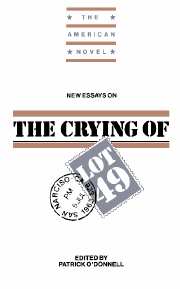Book contents
- Frontmatter
- Contents
- Series Editor's Preface
- 1 Introduction
- 2 Borges and Pynchon: The Tenuous Symmetries of Art
- 3 Toward the Schizo-Text: Paranoia as Semiotic Regime in The Crying of Lot 49
- 4 “Hushing Sick Transmissions”: Disrupting Story in The Crying of Lot 49
- 5 “A Metaphor of God Knew How Many Parts”: The Engine that Drives The Crying of Lot 49
- 6 A Re-cognition of Her Errand into the Wilderness
- Notes on Contributors
- Selected Bibliography
Series Editor's Preface
Published online by Cambridge University Press: 12 January 2010
- Frontmatter
- Contents
- Series Editor's Preface
- 1 Introduction
- 2 Borges and Pynchon: The Tenuous Symmetries of Art
- 3 Toward the Schizo-Text: Paranoia as Semiotic Regime in The Crying of Lot 49
- 4 “Hushing Sick Transmissions”: Disrupting Story in The Crying of Lot 49
- 5 “A Metaphor of God Knew How Many Parts”: The Engine that Drives The Crying of Lot 49
- 6 A Re-cognition of Her Errand into the Wilderness
- Notes on Contributors
- Selected Bibliography
Summary
In literary criticism the last twenty-five years have been particularly fruitful. Since the rise of the New Criticism in the 1950s, which focused attention of critics and readers upon the text itself — apart from history, biography, and society — there has emerged a wide variety of critical methods which have brought to literary works a rich diversity of perspectives: social, historical, political, psychological, economic, ideological, and philosophical. While attention to the text itself, as taught by the New Critics, remains at the core of contemporary interpretation, the widely shared assumption that works of art generate many different kinds of interpretation has opened up possibilities for new readings and new meanings.
Before this critical revolution, many American novels had come to be taken for granted by earlier generations of readers as having an established set of recognized interpretations. There was a sense among many students that the canon was established and that the larger thematic and interpretative issues had been decided. The task of the new reader was to examine the ways in which elements such as structure, style, and imagery contributed to each novel's acknowledged purpose. But recent criticism has brought these old assumptions into question and has thereby generated a wide variety of original, and often quite surprising, interpretations of the classics, as well as of rediscovered novels such at Kate Chopin's The Awakening, which has only recently entered the canon of works that scholars and critics study and that teachers assign their students.
- Type
- Chapter
- Information
- New Essays on The Crying of Lot 49 , pp. vii - viiiPublisher: Cambridge University PressPrint publication year: 1992

